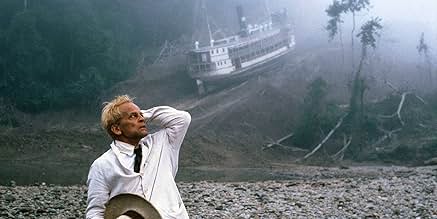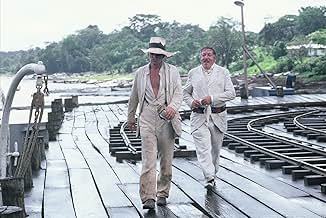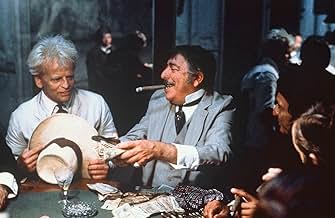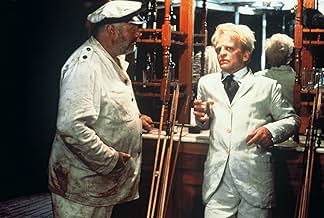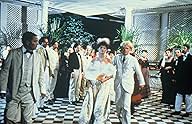Fitzcarraldo
- 1982
- Tous publics
- 2h 38min
Brian Sweeney Fitzgerald, dit Fitzcarraldo, a un rêve : construire un opéra au beau milieu de l'Amazonie. Pour financer son projet, il répare un bateau à vapeur afin de récolter le caoutchou... Tout lireBrian Sweeney Fitzgerald, dit Fitzcarraldo, a un rêve : construire un opéra au beau milieu de l'Amazonie. Pour financer son projet, il répare un bateau à vapeur afin de récolter le caoutchouc d'une zone reculée de la forêt.Brian Sweeney Fitzgerald, dit Fitzcarraldo, a un rêve : construire un opéra au beau milieu de l'Amazonie. Pour financer son projet, il répare un bateau à vapeur afin de récolter le caoutchouc d'une zone reculée de la forêt.
- Réalisation
- Scénario
- Casting principal
- Nomination aux 1 BAFTA Award
- 4 victoires et 4 nominations au total
- Cholo
- (as Miguel Angel Fuentes)
- Huerequeque (The Cook)
- (as Huerequeque Enrique Bohórquez)
- Station master
- (as Grande Othelo)
- Rubber Baron
- (as Rui Polanah)
- Old Missionary
- (as Salvador Godinez)
- Notary
- (as Bill Rose)
- Opera Singer
- (non crédité)
- Opera Singer
- (non crédité)
- Wilbur (scene cut)
- (non crédité)
Avis à la une
The most famous image in the film is the hauling of a large steam-boat up the side of a mountain (a feat which was achieved by the film-makers without the aid of special effects). Visually, the film is spectacular and everything is beautifully photographed. Kinski is superb as the crazed adventurer.
On the minus side, however, some viewers might be put off by the slow pace of the film.
This film stands as one of Herzog's best, and most accessible works, and is a must-see for anyone.
With his white coat, white hat, and his bleached blonde hair, Fitz is quite an eccentric. In a social context, he's an outsider. But he has a bold vision. His romantic sidekick is a woman named Molly (Claudia Cardinale). As a compliment to Fitz, she speaks the film's theme: "It's only the dreamers who move mountains".
After some preparation early in the film, Fitz and crew set sail up the Amazon on a huge boat, to stake out a claim for their business that will bring in the money to advance Fitzcarraldo's dream. The boat is equipped with all the necessities, which include, naturally, a gramophone to play the operatic music of Enrico Caruso. And the best sequences of the film are those set in the remote jungle, as the boat moves through a large tributary of the Amazon, into headhunter territory. With the gramophone blaring out opera amid the sound of Indian war drums, it's the unusual contrast between the primitive and the cultural that makes this film interesting.
Filmed entirely in South America, the story is set in the early years of the twentieth century, long before the advent of television or automobiles.
Color cinematography is quite good. This is a very physical story. Most scenes take place outdoors. And the remoteness of the setting conveys a sense of doom, a sense of unknown terror and foreboding.
While the visuals are stunning, some aspects of the story I'm just not sure about. I never did figure out the significance of the ice. Is that a reward for Indian cooperation? If so, how can ice be preserved in a land without electricity? And without electricity, isn't the whole idea of an opera house in the wilderness a tad ludicrous? Maybe these questions are all answered and I just missed them. Even so, these issues could have been better addressed in the script.
Not as deeply thematic as "Aguirre: The Wrath Of God" (1972), Werner Herzog's "Fitzcarraldo" nevertheless is an unusual film, one that is worth watching for its stunning visuals and thematic contrasts, its physicality, and the eccentric character of Fitzcarraldo, the dreamer who can move mountains.
Arguably, Klaus Kinski (as Fitzcarraldo) was born to play the main role although Werner Herzog considered taking up the role himself. But, no one can play an eccentric the way Kinski did in this film. It's not Nosferatu (1979), but the wide, staring eyes are looking at you, all the time, in the same spooky way.
And, only an eccentric of the most magnificent kind would dare to take a 340-ton ship up the Amazon and carry it over a mountain down to another river! Isn't that just one of the craziest things you've ever heard of? Well, the truth is Herzog actually did do that and simply used Kinski as his surrogate to prance around the mud and clay, with the local Indians, and generally taking the praise for a job well done. There were no special effects the production team actually pushed and pulled that hulk up a slope of hundreds of meters and then down to another river.
So, who was really crazy: Herzog or Fitzcarraldo?
Never mind that: just see this movie for the lush, primeval jungles of South America; for the rich tones of various opera singers, including Caruso (on a phonograph); for the stunning photography aboard the ill-fated Molly; for the antics of Kinski, as he thrashes around, pushing himself and others to the limits; for the army of local Indians, pulling the ship over the mountain; for the haunting sound-track provided by Popul Vuh, Herzog's perennial musical team of choice; and, of course, for the lovely Claudia Cardinale past her prime but still remarkable...
I love this movie and I hope you do also. And, when you have seen it, then see Burden of Dreams (1982), the film that tells the story of the making of Fitzcarraldo. It's maybe better than the fiction...
This seems especially true of "Fitzcarraldo," which, sets a hundred years ago, begins with an Irish colonist who had a passion for opera rowing 1,200 miles down a South American river, accompanied by the madam of a brothel, in order to hear the great Caruso perform
Inspired by this experience, Fitzcarraldo embarks on a grandiose plan to open up the Amazonian jungle to river transport, providing access to new rubber plantations and thereby making enough money to build an opera house
Herzog's favorite actor, Klaus Kinski, is as appropriately manic as Fitzcarraldo, eyes glittering madly as he pursues his vision In the central sequence he organizes a tribe of Indians to help him pull a steamboat across a mountain in order to by-pass dangerous rapids
"Fitcarraldo" seems by turns admiring of its hero's megalomania and mocking of his hubris, with no illusions about the cynical exploitation of the region's riches by the rubber barons whom Fitzcarraldo tries to defeat by cleverness Ultimately though, it is the sheer spectacle which we remember
Le saviez-vous
- AnecdotesKlaus Kinski was a major source of tension on set, because he fought violently with the crew and raged over trivial matters. The natives were very upset about his behavior. Werner Herzog has claimed that one of the chieftains offered, in all seriousness, to murder Kinski. However, Walter Saxer, the production manager of this film, later confirmed that Herzog's story was not true.
- GaffesDuring one of boat drifting scene, crew members are visible at the top of the boat, including a man in jeans who tries to avoid the camera.
- Citations
Brian Sweeney Fitzgerald - 'Fitzcarraldo': How can anyone learn patriotism from a school book?
Young Missionary: The Government requires it.
Old Missionary: The natives get used to it. Like vaccination.
Young Missionary: The children already feel like little Peruvians. The other day I asked them, "Are you Indians?" "No," they said, "not we, the ones up the river, they are Indians." And then I asked. "What are Indians?" "They said to me "Indians are people who can't read and who don't know how to wash their clothes."
Brian Sweeney Fitzgerald - 'Fitzcarraldo': And what about the older people?
Old Missionary: Well, we can't seem to cure them of the idea that our everyday life is only an illusion, behind which lies the reality of dreams.
Brian Sweeney Fitzgerald - 'Fitzcarraldo': Actually, I'm very interested in these ideas. I specialise in opera myself.
- ConnexionsEdited into Spisok korabley (2008)
- Bandes originalesOpera in Manaos
from "Ernani" by Giuseppe Verdi
Production: Werner Schroeter
Ernani: Veriano Luchetti (voice)
Costante Moret (actor)
Silva: Dimiter Petkov (voice and actor)
Elvira: Mietta Sighele (voice)
Singer at orchestra: Lourdes Magalhaes
Sarah Bernhardt: Jean-Claude Dreyfus (as Jean-Claude Dreyfuss)
Stage design: Gianni Ratto
Orchestra of the Filarmonica Veneta
Conducted by Giorgio Croci
Meilleurs choix
- How long is Fitzcarraldo?Alimenté par Alexa
Détails
- Date de sortie
- Pays d’origine
- Langues
- Aussi connu sous le nom de
- Фіцкарральдо
- Lieux de tournage
- Plaza de Armas, Iquitos, Pérou(Fitzcarraldo's house)
- Sociétés de production
- Voir plus de crédits d'entreprise sur IMDbPro
Box-office
- Budget
- 14 000 000 DEM (estimé)
- Montant brut mondial
- 4 475 $US
Contribuer à cette page



